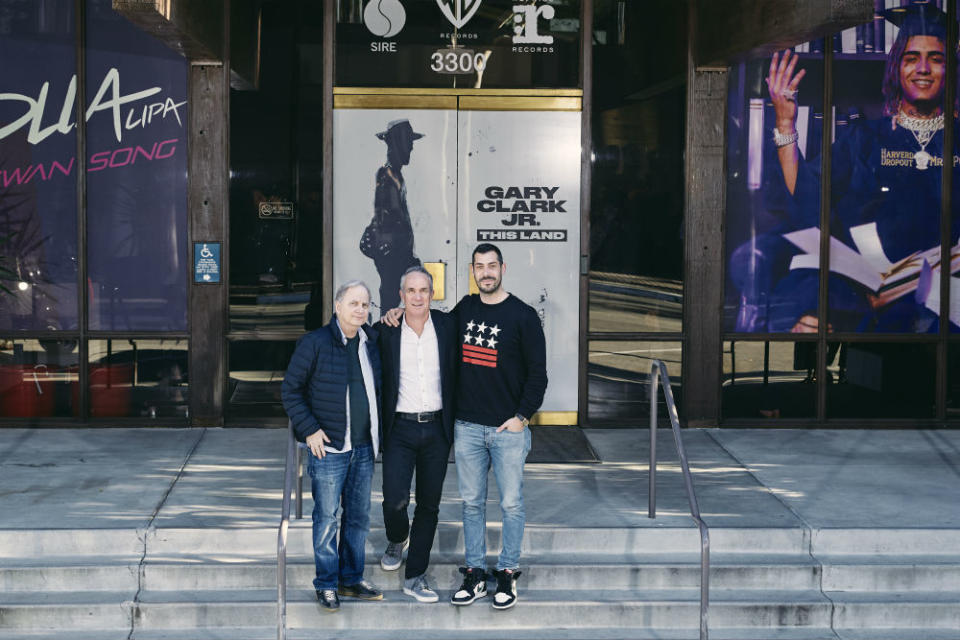Warner Bros. Records Says Goodbye to Its Legendary Burbank ‘Ski Lodge’ Headquarters

Today, Warner Bros. Records says goodbye to 3300 Warner Blvd. in Burbank — the venerable company’s home since 1975. At the time the label moved into the 89,452-square foot architectural landmark, affectionately dubbed the “ski lodge,” its top artists included James Taylor, the Doobie Brothers, Alice Cooper, Van Morrison and a recently reconfigured British group called Fleetwood Mac, who’d just been joined by a young couple named Stevie Nicks and Lindsey Buckingham.
The entire label, along with the rest of Warner Music Group’s L.A. companies — including the labels, distribution and Warner/Chappell publishing — is moving to a former Ford Model T factory and showroom in the downtown L.A. arts district.
Related stories
Atlantic Records U.K. Overhauls Label Structure
Warner Music Names Scott Cohen Chief Innovation Officer of Recorded Music
Spotify's India Launch Is Imminent as Company Reveals Pricing
A week’s worth of festivities culminated Wednesday night in a champagne toast and photo opportunity for all current employees of the fabled building — designed by noted architect A. Quincy Jones — which is still owned by Warner Bros. Pictures. Co-chairman/CEO Aaron Bay-Schuck and co-chairman/COO Tom Corson, who just arrived in their positions last year, stepped aside to allow longtime label president and A&R chief Lenny Waronker, who is still a consultant for the label, to take the floor.
“I don’t believe we signed one artist because of this building,” said Waronker (pictured below, left with Corson, center, and Bay-Schuck). “It was the people inside this building.”
It was a fitting tribute to the iconic, tree-shaded building, which has named to the L.A. Conservancy’s list of historic sites and seems a certain candidate for landmark status. The office’s famed indoor, leafy nooks and crannies — which provided convenient cover for certain stoner executives to take a cannabis break — were now stripped down to the bare essentials, with plenty of leftover CDs, albums and promotional items there for the taking.
“From the first time I bought a Small Faces album at College Records in Northridge, I noticed the palm trees on the label and realized there was a record company in the Valley,” says longtime Warner Bros. VP Publicity Rick Gershon as he cleared out his office, and explained the good fortune of eventually working there for a quarter-century.
Bob Merlis, who first moved from Warner Bros.’ New York offices to Burbank at the tail end of 1975, right after the new headquarters opened, remembers everyone on the staff getting a souvenir coffee mug to commemorate that first year.

“I actually never heard this building referred to as the ‘ski lodge’ until much later,” notes Merlis, who left the company in 2001. “When someone said the architect was A. Quincy Jones, I asked, ‘The Quincy Jones?’ — no,” he laughs. “It was like an Abbott & Costello ‘Who’s on first?’ routine: ‘No, A Quincy Jones.’”
Merlis remembers there were all sorts of rules about decorating your office, including no thumb tacks, though eventually it was discovered the cedar paneling covered any holes left in the wall.
“It was always a warm and fuzzy environment as opposed to a cold corporate atmosphere,” Merlis said. “I covered my office in tchotkes and was even allowed to smoke a cigar in there.”
One of Merlis’ memories involves the longtime parking attendant Howard Washington, who would shout at one and all, no matter their stature. The one-time Jack Warner valet had a bit part as a sleeping room porter in Alfred Hitchcock’s classic, “Strangers on a Train,” and his solution to every automotive problem was “jumper cables.”
“He would tell David Lee Roth he was parking in the wrong spot,” says Merlis, who notes the parking structure at the back was named “The Howard Washington Auto Spa” by former exec Stan Cornyn.
Still as Waronker pointed out, the magic was in the people who passed through the ski lodge. There were performances and beers served in the building’s patio courtyard, where Prince once played a set for the label.
“People who worked there realized amazing things happened in that building,” adds Merlis. “There was really a reverence for the aura. Artists like George Harrison would just pull up, walk through the door and say hi to everybody.”
In later years, as personnel and budget cuts caused some areas of the building to be vacated, 3300 lost some of its buzz. But for those who worked there, or even had occasion to visit, those exotic offices held an unmistakable allure — laid-back, but with the buzz of creativity.
“I lived at 3300 longer than anywhere else in my life,” says Merlis. “When you’re with an organization recognized as the hippest and most respected, you can feel that esprit de corps. There was a real difference back then between Warner Bros. Records and everybody else.”
Now, it’s up to Warner Bros.’ new leadership of Corson and Bay-Schuck to create their own culture in a historic downtown setting, one that suits the impressive legacy of what took place at 3300 Warner Blvd.
Sign up for Variety’s Newsletter. For the latest news, follow us on Facebook, Twitter, and Instagram.

